Arbitrum One Ecosystem Analysis - Sustainable Growth
Arbitrum One is no longer merely a Layer-2 scalability solution for Ethereum; it is evolving into a new economic layer that merges a variety of asset classes and industries across Web3
INSIGHTS
7/5/202512 min read
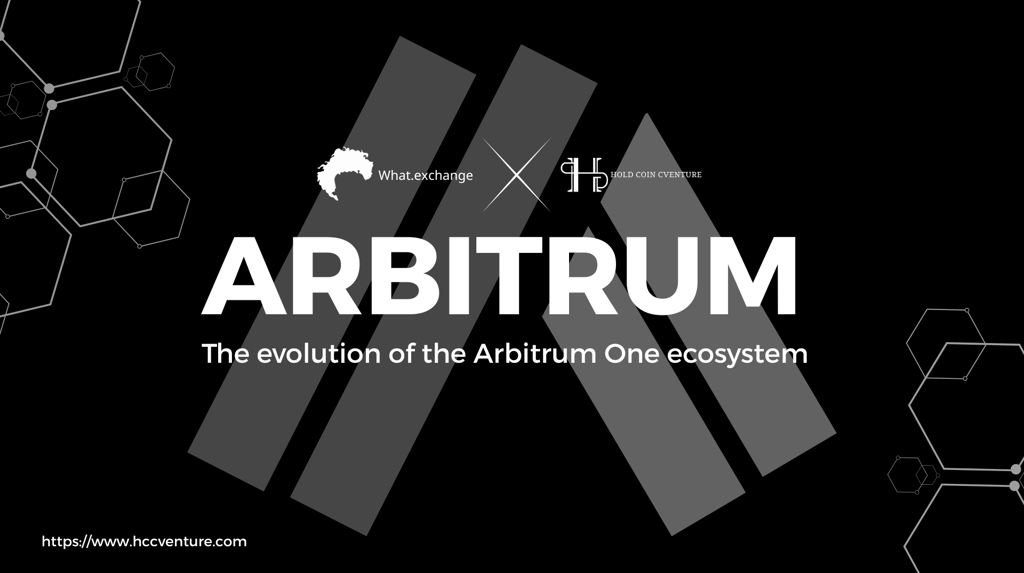

Overview of Arbitrum One and Its Ecosystem
Arbitrum One, the premier Layer-2 protocol on Ethereum developed by Offchain Labs, has rapidly established itself as a pillar of the infrastructure for decentralized finance (DeFi) applications, real-world asset (RWA) tokenization, and AI-native protocols.
Arbitrum's dominant presence among Layer-2s in terms of total value locked (TVL), stablecoin supply, and real transaction volume was further solidified by numerous technological advancements, traditional partnerships, and on-chain growth in June 2025.
Impressive figures updated to date:
TVL: 8.6B USD (highest among Layer-2s) (data updated Tokenterminal)
Stablecoin outstanding: 5.6B USD, accounting for ~65% of total TVL
DEX trading volume (30D): 17B USD
Active addresses: ~500,000 (near ATH in 2025)
Active Loans: 770M USD (recovered ~33% from Q2 bottom)
Total value of RWAs: 300M USD
ARB price: fluctuating between 0.32 – 0.39 USD
On-chain Analysis of the Arbitrum One Ecosystem
According to the most recent data from Arbiscan, the Arbitrum One Daily Transactions Chart has seen some significant upswings. On November 17, 2024, the session reached over 2.05 million transactions per day, which is among the greatest numbers ever recorded for any Layer-2 network.
Transaction volumes steadily remained above one million transactions per day, with a noticeable uptick from April to June 2025, despite a minor pullback thereafter.
The introduction of L3 Orbit applications, the YAPYO token presale campaign, and the Robinhood alliance are just a few of the significant ecosystem events that have contributed to this steady growth. These events have stimulated real user demand from DeFi participants as well as tokenized securities dealers.
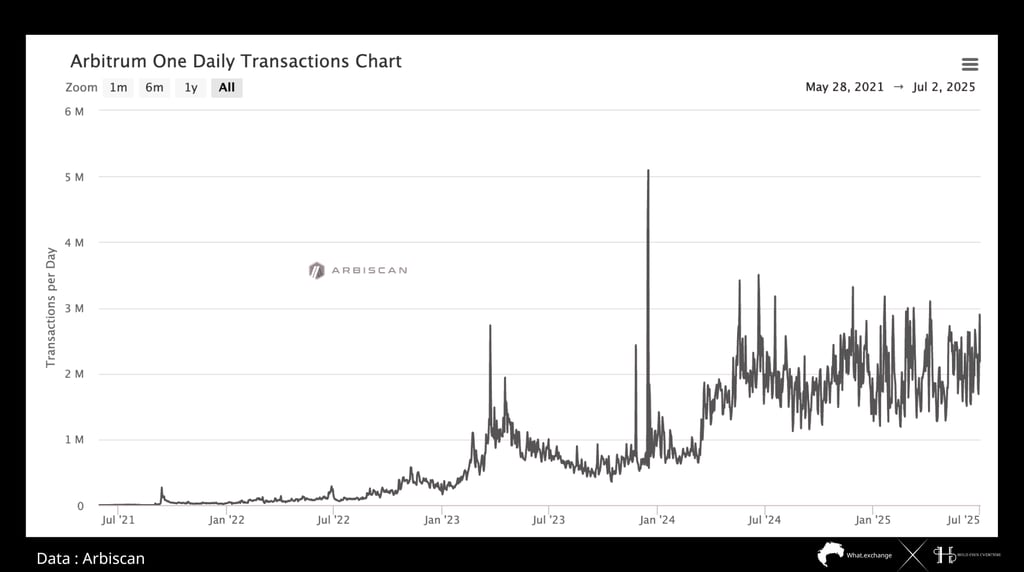

The growing number of Arbitrum users is also seen in the "Unique Addresses" chart. The number of unique wallets expanded significantly from about 48 million to over 61 million between the beginning of 2025 and early July 2025, with an average of about 2 million new wallets each month. This pattern shows that, in addition to increasing the volume of transactions, Arbitrum is laying the groundwork for sustained user growth, which will be fueled by network effect momentum and organic onboarding.
A dense series of events throughout the month, such as the YAPYO presale (InfoFi), partnership announcements with Robinhood and Gemini, and the rollout of new Layer-3 infrastructure via Arbitrum Orbit, fueled the momentum.
It is important to note that these are not merely short-term growth spikes; rather, they are indicators that the Arbitrum ecosystem has reached a certain level of maturity, where speculative capital flows and genuine usage-based capital coexist in parallel.

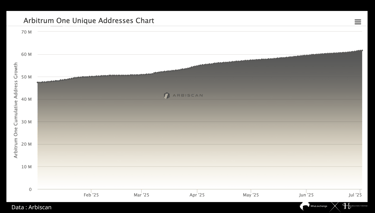
The conversion rate from new users to actual engaged users is also higher than the average across other chains, suggesting that the platform has the ability to build a strong community and retain users. Arbitrum is on the brink of achieving a sustainable level of network activity, particularly if L3 applications, including AI applications, asset tokenization, and GameFi, continue to expand in H2/2025, given the current growth momentum.
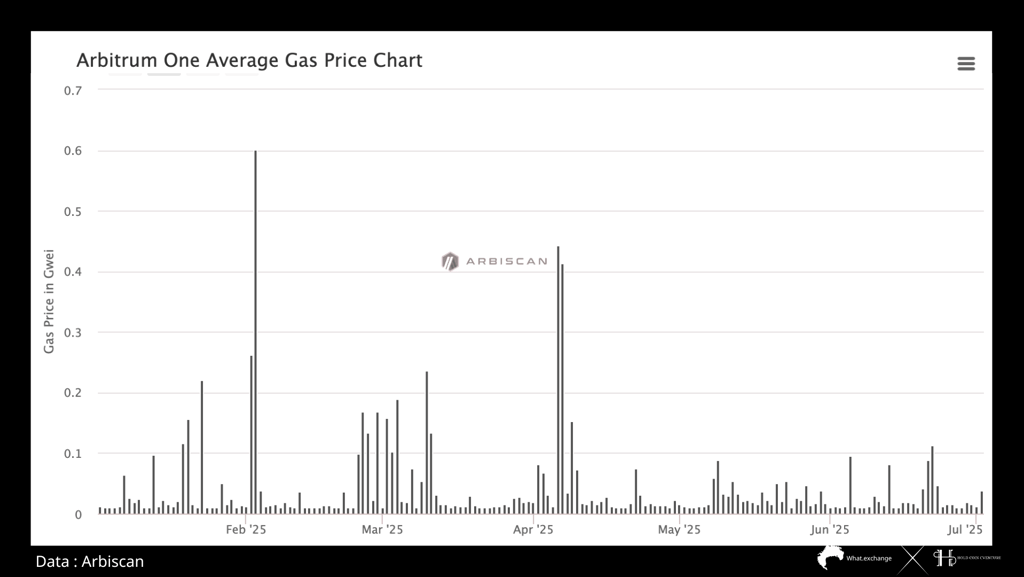

Gas fees are among the most critical factors in assessing the competitiveness and scalability of any Layer-2 within the Ethereum ecosystem. Gas is not merely a cost that users incur to execute transactions; it is a cost barrier that directly influences the feasibility of deploying complex applications, such as GameFi, SocialFi, or AI-native apps, and directly impacts usage behavior and user experience.
Arbitrum's strategic advantage is its capacity to reduce transaction fees while maintaining high performance, which is driving both short- and long-term adoption in the face of increasing competition among Layer-2s.
Throughout the first half of 2025, Arbitrum One's Gas Price (Gwei) and Transaction Fee (ETH) charts show a generally downward trend with a few sporadic upswings.
Gas prices generally stayed within the low range of 0.015–0.03 Gwei, which is indicative of Arbitrum's very effective infrastructure. Nonetheless, there were sporadic spikes above 0.6 Gwei, especially in late February and early April 2025, when new Layer-3 chains and staking incentive schemes were introduced.
The majority of sessions showed incredibly low average fees, much lower than those on the Ethereum mainnet and even many other Layer-2 networks, despite these short spikes. This further solidified Arbitrum's standing as an affordable platform for both consumers and developers.
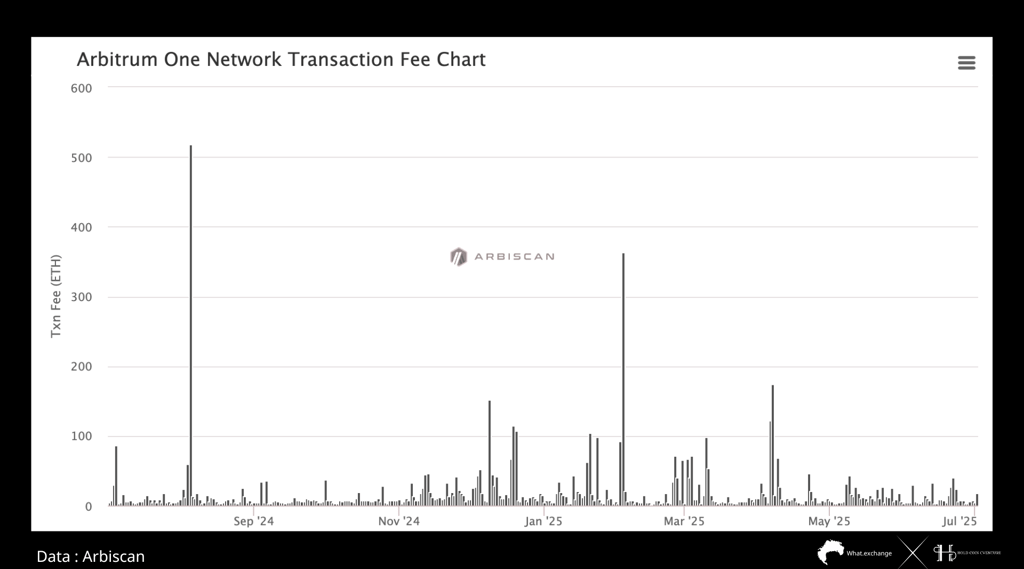

Arbitrum will be able to directly compete with competitors such as Optimism, Base, and zkSync Era in the long term as a result of the low fees. The capacity to provide ultra-low processing costs while maintaining strong security and fast finality is a critical factor in becoming the standard infrastructure Layer-2 for the next generation of blockchain applications, particularly in fee-sensitive segments such as micro-payments, high-frequency DEXs, on-chain games, and AI protocols.
With most days registering less than 20 ETH/day, Arbitrum's overall network fees (in ETH) have stayed remarkably low over the past year. There were just a few notable outliers, including September 2024, when fees topped 500 ETH each day, most likely as a result of noteworthy occasions or irregularities pertaining to contracts.
The general pattern of consistent and long-term fee reduction highlights Arbitrum's accomplishments in batch optimization, cost cutting, and the successful deployment of the Ethereum Pectra Upgrade.
Long-term, Arbitrum is a great option for high-frequency applications like SocialFi, GameFi, and DePIN because of its capacity to keep gas prices low. Additionally, it dramatically reduces the entry barrier for Layer-3 chain deployment, enhancing Arbitrum's position as a scalable, core infrastructure layer for the upcoming Web3 revolution.
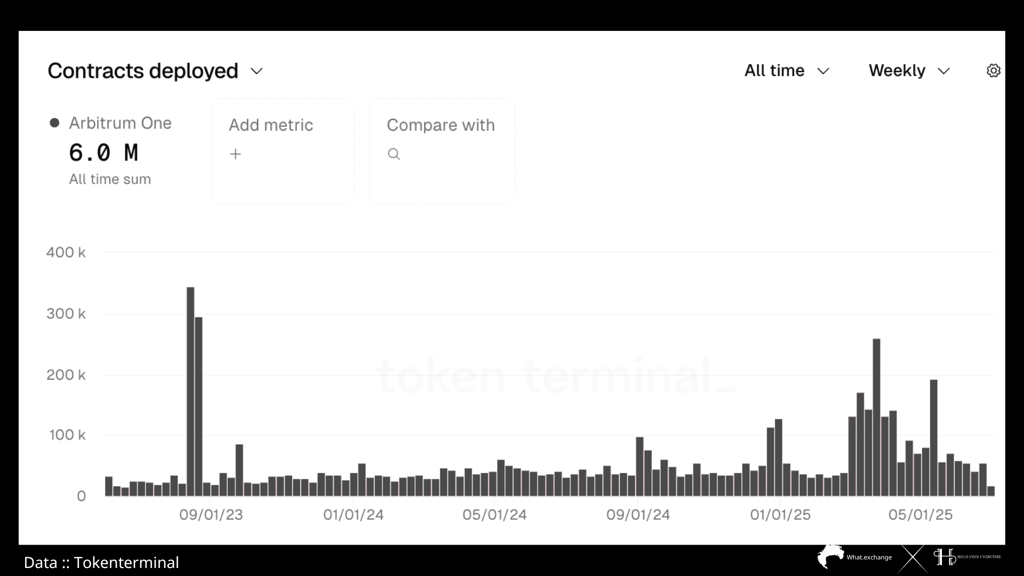

The deployment of smart contracts is a critical metric that reflects the pace of ecosystem expansion and the activity of developers. The volume of deployed contracts indicates long-term commitment and development potential from project teams, while user numbers indicate a platform's appeal to the broader community.
According to data from Token Terminal, there were more than 6 million smart contracts deployed on Arbitrum One as of early July 2025. Since the start of 2025, there has been a noticeable rising trend in the weekly "Contracts Deployed" graphic. Notably, approximately 200,000 new contracts were deployed during several weeks between February and April 2025, indicating a boom in activity from Layer-3 apps, new development teams, and auto-deploy mechanisms (such as factory contracts).
It's interesting to note that this increase in contract deployment did not coincide with a rise in gas prices. This is because WebAssembly's cost-effective contract deployment is made possible by the Stylus engine and effective batching mechanisms.
The foundation for a new generation of automated, high-volume Web3 apps is laid by this, which reflects Arbitrum's infrastructure optimization and makes it possible for AI agents and auto-contract generators to function scalably and economically on Layer-2.
The growth was primarily driven by two primary factors:
(1) Arbitrum Orbit, which enables customizable Layer-3 deployments.
(2) Stylus, which supports smart contract development in Rust, C, and C++, thereby opening the door for developers from outside the traditional EVM ecosystem. This has prompted new applications to launch their own dedicated contract systems.
Nevertheless, additional monitoring is required to ascertain the sustainability of this growth, with a particular emphasis on metrics such as contract verification rates, real user interactions, and transaction volumes that originate from these contracts. Speculative behavior or bot-driven deployment may be suggested by an increase in contract numbers that does not correspond to real activity. However, this contract boom is more likely to indicate a genuine developer-driven growth cycle, as evidenced by the current data, as well as the increasing user counts and DEX volume.
With this growth momentum, Arbitrum is steadily positioning itself as the ideal “execution layer” for the next generation of dApps—a platform capable of deploying millions of contracts at minimal cost while still maintaining the security and performance standards of Ethereum. When combined with the strong rise in active users and stablecoin supply, it's reasonable to expect that the number of deployed contracts will continue increasing and remain elevated through the end of the year.
This convergence of low-cost infrastructure, developer accessibility, and high user liquidity solidifies Arbitrum's role as a core layer for scalable, high-throughput Web3 applications.
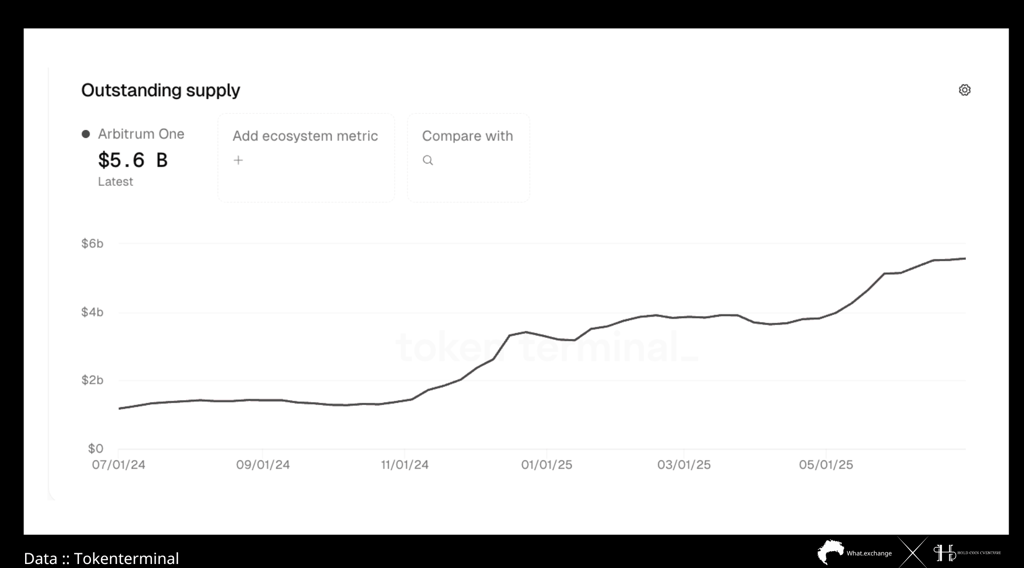

Stablecoins are a fundamental asset class that are essential to the functioning of any blockchain ecosystem, particularly within Layer-2 infrastructure. The platform's capacity to sustain and expand the circulating supply of stablecoins is indicative of the availability of liquidity to facilitate DeFi activities, including lending, farming, yield optimization, and decentralized trading (DEX). This is a reflection of user trust in the platform.
The ecosystem is becoming one of the most stable liquidity centers on Ethereum, as evidenced by the fact that Arbitrum One has recorded over 5.6 billion USD in circulating stablecoins.
Arbitrum's preference for USDC issued directly by Circle remains dominant in the face of broader market competition between native and wrapped stablecoin standards (e.g., USDC vs. USDC.e). The high level of trust from both retail users and institutions is evidenced by the near-absolute share of USDC in the total stablecoin supply.
This is particularly noteworthy since numerous other Layer-1s are still experiencing fragmented stablecoin distribution or declining volumes as a result of users withdrawing capital or transitioning to lower-cost Layer-2s. The significant increase from approximately 1.3 billion USD at the end of 2024 to over 5.6 billion USD by mid-2025 (+330%) indicates that capital is being accumulated in USDC on Arbitrum for genuine utility purposes, rather than mere speculation.
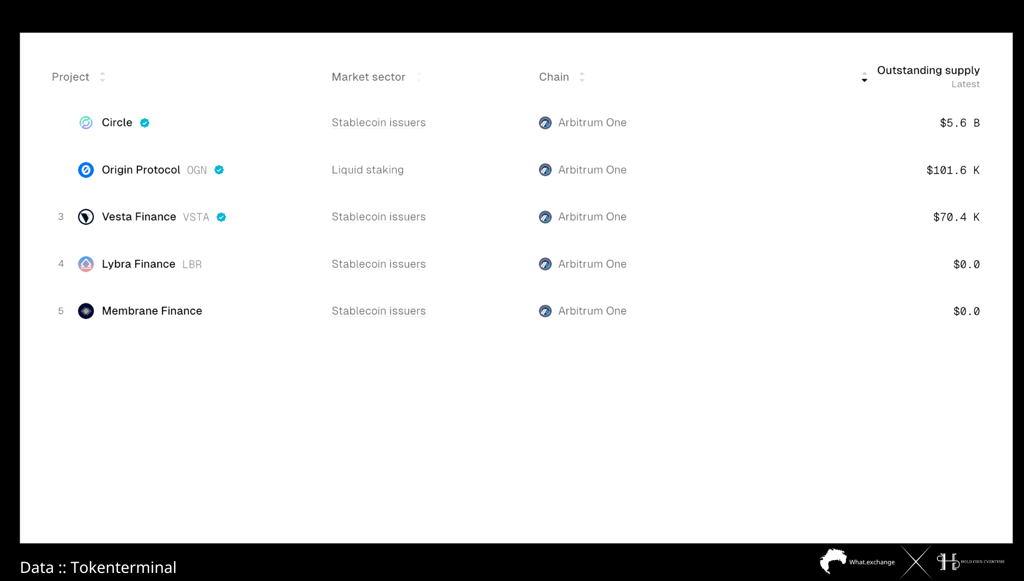

Arbitrum is emerging as an optimal "liquidity haven" for large-scale DeFi protocols and transactions that necessitate rapid confirmation speeds due to its infrastructure-stable, fast, and low-cost transaction processing capabilities.
The high volume of stablecoins also enables lending protocols to expand borrowing capacity, reduce liquidation risks, and maintain stable interest rates. Arbitrum is well-positioned to maintain its status as a leading stablecoin liquidity hub within the broader Ethereum ecosystem in the long term, provided that this capital flow continues to grow. This will lay the groundwork for the explosive growth of Layer-3 networks, real-world assets (RWA), and next-generation DeFi.
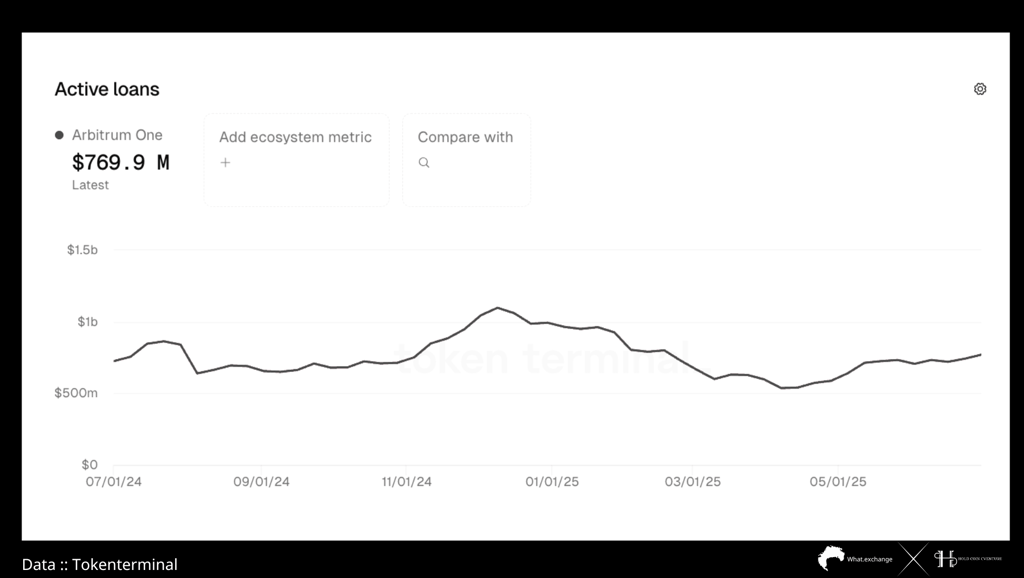

The lending market is a critical component of the DeFi ecosystem, as it demonstrates the genuine utility of stablecoins, user trust, and the capacity to generate cash flow from held assets. The current Active Loans figure on Arbitrum is approximately 770 million USD, which is a substantial recovery of approximately +33% from the low of approximately 580 million USD in April 2025. This rebound indicates that market sentiment is improving and that there is a renewed trend of controlled leverage usage by users.
The Aave protocol remains the most prevalent, comprising more than 65% of all active loans. This underscores a user inclination toward the "safe haven" model for stablecoins, which favors transparent, established lending platforms with clearly defined risk management frameworks..
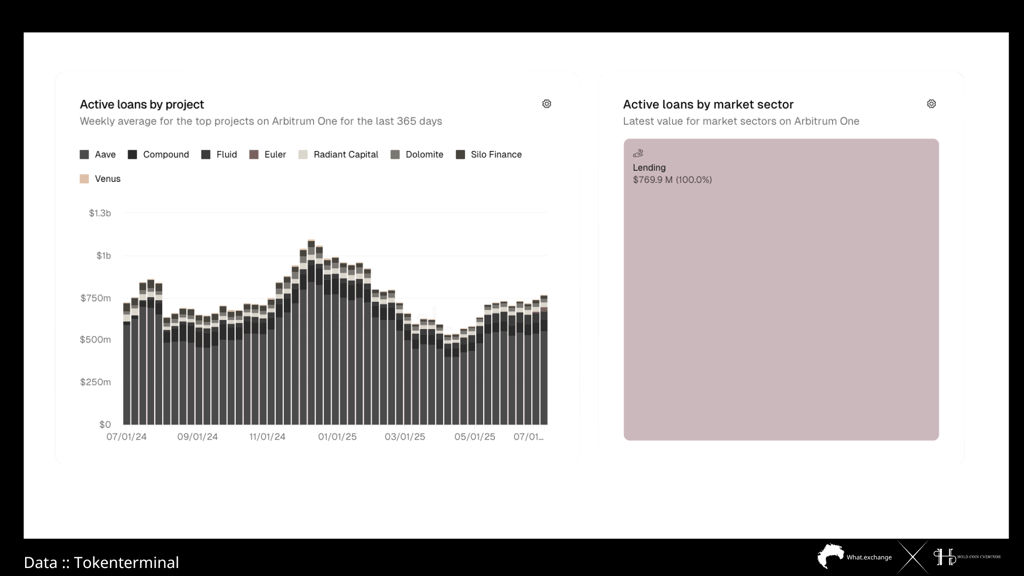

In addition to Aave, platforms such as Compound, Fluid, Euler, Silo, and Dolomite are actively contributing to the fragmentation and diversification of Arbitrum's lending ecosystem, particularly in the context of isolated lending and fixed-rate products.
Market behavior suggests that user strategy has changed in comparison to early 2025. Users are now inclined to reduce leverage, favoring stablecoin deposits into Aave for stable yields or using them as collateral within yield aggregator protocols. The lending utilization rate is currently approximately 13.7%, which indicates that there is significant potential for growth in the lending sector, given Arbitrum's total stablecoin TVL of approximately 5.6 billion USD.
Arbitrum is well-positioned to attract DeFi lending capital as off-chain interest rates begin to decrease. This is due to its low transaction costs, high throughput, and flexible risk management tools, which make it an increasingly appealing destination for next-generation lending activity.
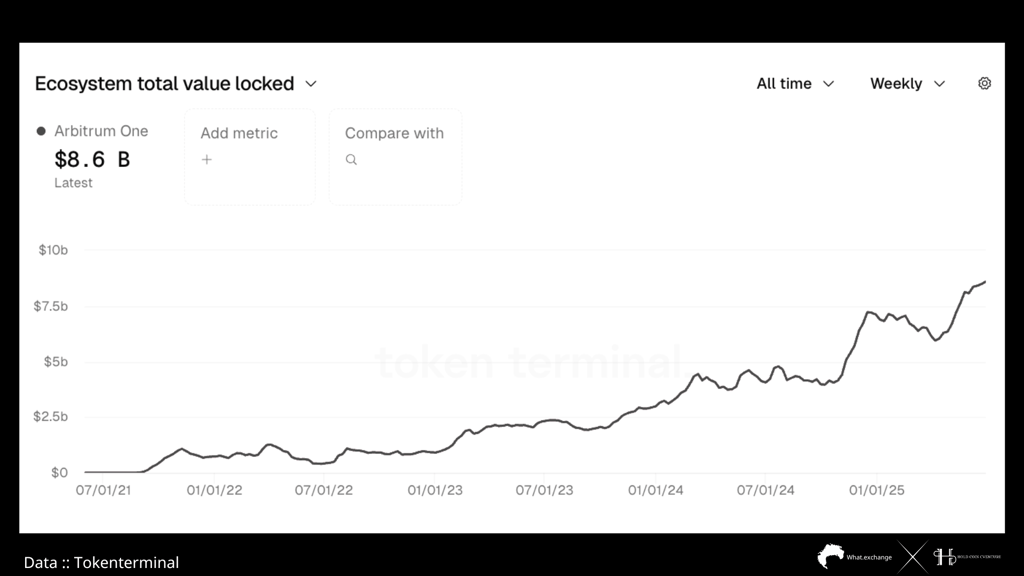

Two fundamental metrics are employed to evaluate the capacity of a Layer-2 ecosystem to attract and effectively utilize real capital: the total value locked (TVL) and the capital bridged from Ethereum to Arbitrum.
The total value of assets actively used within on-chain protocols (such as DEXs, lending platforms, farming, etc.) is represented by TVL, while bridge deposits represent the inflow of new capital into the network from external sources. The discrepancy between these two metrics is of considerable significance: A high TVL but low bridge volume suggests that the ecosystem is proficient in the efficient retention and recycling of internal capital, a trait that mature blockchains exhibit as they expand in depth rather than just breadth.
Arbitrum's TVL, which reached 8.6 billion USD by the end of June 2025, was the highest in its history and the most significant figure among all Ethereum Layer-2s.
Conversely, bridge deposits are currently valued at 4.6 billion USD, a significant decrease of approximately 67% from their peak of 14 billion USD in Q1 2024. This leads to a deployed/bridge ratio of approximately 186%, which indicates that capital is not merely entering and exiting the network, but is instead flowing continuously across multiple protocols within the Arbitrum ecosystem. This high capital efficiency is a strong indicator of long-term sustainability and ecosystem maturity.
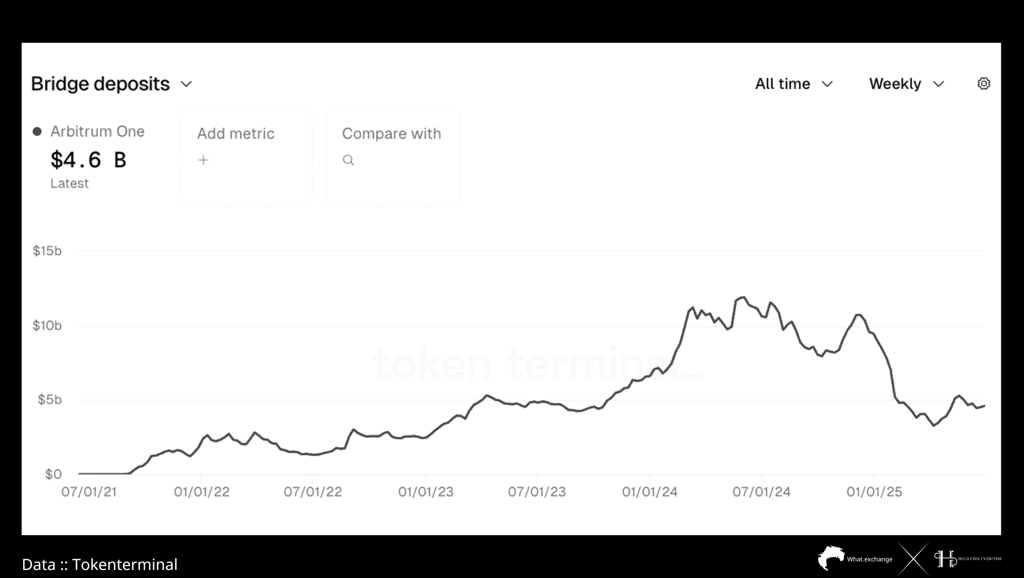

This trend is indicative of the increasing confidence of users in the Arbitrum ecosystem, as they are opting to retain assets for long-term participation rather than bridging in for short-term incentives such as airdrops. The data also emphasizes the ecosystem's maturity, as existing capital is being effectively reinvested, despite the fact that new capital is not flowing in at a rapid pace.
Conversely, the decrease in bridge deposits is a signal that warrants monitoring in relation to the onboarding of new users, a critical obstacle for Arbitrum if it intends to expand TVL beyond the $10B+ threshold.
Arbitrum could sustain high TVL levels without relying heavily on new inflows from Ethereum in the future, provided that marketing campaigns, Layer-3 applications, and TradFi partnerships continue to expand. Arbitrum will be able to maintain its resilience against market shocks and cultivate a more sustainable ecosystem by utilizing a development model that is based on endogenous liquidity.
June 2025: Key Ecosystem Highlights
Upgrades to Arbitrum Orbit Technology and Stylus
Arbitrum announced significant updates to Stylus on June 13, 2025. These updates permitted the development of smart contracts in Rust, C, and C++ through WebAssembly. Additionally, Arbitrum Orbit enabled developers to launch custom Layer-3 chains by utilizing Arbitrum Nitro technology. Furthermore, the integration of Zero-Knowledge Proofs and a decentralized sequencer was expedited, with the anticipated completion date of the end of 2025.
These enhancements strengthen Arbitrum's scalability and security by attracting a broader developer base and enhancing flexibility, thereby enabling it to more effectively compete with other Layer-2s such as Optimism and zkSync.
Arbitrum Integrates Ethereum Pectra Upgrade
Arbitrum implemented Ethereum's most recent Pectra Upgrade on June 18, 2025, with the objective of optimizing user experience and performance. Usability and development efficiency are enhanced by features such as gas sponsorships and one-click swaps. The upgrade enhances Arbitrum's scalability and throughput, allowing for a greater number of transactions at a reduced cost. This makes it more appealing to developers, particularly those in the DeFi and GameFi sectors.
Yapyo InfoFi Token Presale Launch
InfoFi, a SocialFi infrastructure project within Arbitrum, initiated its YAPYO token presale in late June, which garnered the interest of the DeFi community. The event, which was facilitated by AI partners Kaito and CookieDAO, resulted in a significant increase in demand for ARB, USDC, and ETH on Arbitrum, as these were necessary for presale participation. This, in conjunction with the Robinhood partnership announcement, led to a trading volume increase of more than 500% within 24 hours, resulting in $770M in ARB traded.
Arbitrum is the preferred platform for tokenized stocks at Gemini.
The launch of tokenized MicroStrategy (MSTR) stocks for EU users on Arbitrum by crypto exchange Gemini has surpassed traditional market limitations, including high international fees and restricted hours, by enabling 24/7 trading. Gemini guarantees liquidity, transparency, and complete economic equivalence to the underlying stock by collaborating with Dinari to establish tokenized security infrastructure. With Arbitrum's Layer-2 blockchain, transactions are executed at a faster pace and at a lower cost than those of conventional exchanges.
Collaboration with Robinhood
Robinhood's collaboration with Arbitrum was one of the most significant announcements of June. Robinhood disclosed its intention to enable EU users to trade more than 200 U.S. stocks and ETFs in tokenized form, with real-time dividend payouts, on June 30, 2025.
The strategic expansion of both firms into on-chain finance will be marked by the launch of these tokenized securities on Arbitrum One and their subsequent migration to a dedicated Layer-2 that is built with Arbitrum's technology.
Assessment and Conclusion
Arbitrum One is transitioning into a Layer-2 infrastructure that is fully integrated, encompassing DeFi, TradFi, SocialFi, and AI-native protocols. Arbitrum's status as a pioneer in traditional asset tokenization and RWA is further solidified by the integrations with Robinhood and Gemini. Stylus and WebAssembly enable Rust/C developers to access the platform, thereby expanding its capabilities beyond Solidity.
Nevertheless, obstacles persist:
Diversification of protocols is required due to the high concentration of TVL and lending in Aave.
Potential onboarding challenges for new users are indicated by a 67% decrease in bridge deposits.
Arbitrum continues to be the foremost Layer-2 provider of liquidity, TVL, and RWA data, despite these challenges. A new growth wave from AI/Game-focused L3s and cross-chain ecosystems is possible in H2/2025.
In conclusion, Arbitrum One is no longer merely a Layer-2 scalability solution for Ethereum; it is evolving into a new economic layer that merges a variety of asset classes and industries across Web3. The foundation for sustained, long-term growth is established by its alignment with TradFi partners, AI-native protocols, DeFi, and RWA.
Disclaimer: The information presented in this article is the author's personal opinion on the cryptocurrency field. It is not intended to be financial or investment advice. Any investment decision should be based on careful consideration of your personal portfolio and risk tolerance. The views expressed in the article do not represent the official position of the platform. We recommend that readers conduct their own research and consult with a professional before making any investment decisions.
API & Data: Dune, Atermis, Galaxy Digital, Tokenterminal, Arbiscan
Compiled and analyzed by HCCVenture and WHAT Exchange
Join HCCVenture here: https://linktr.ee/holdcoincventure
See more Insight Researches :
Explore HCCVenture group
HCCVenture © 2023. All rights reserved.


Connect with us
Popular content
Contact to us
E-mail : holdcoincventure_contact@hccventure.com
Register : https://linktr.ee/holdcoincventure
Disclaimer: The information on this website is for informational purposes only and should not be considered investment advice. We are not responsible for any risks or losses arising from investment decisions based on the content here.


TERMS AND CONDITIONS • CUSTOMER PROTECTION POLICY
ANALYTICAL AND NEWS CONTENT IS COMPILED AND PROVIDED BY EXPERTS IN THE FIELD OF DIGITAL FINANCE AND BLOCKCHAIN BELONGING TO HCCVENTURE ORGANIZATION, INCLUDING OWNERSHIP OF THE CONTENT.
RESPONSIBLE FOR MANAGING ALL CONTENT AND ANALYSIS: HCCVENTURE FOUNDER - TRUONG MINH HUY
Read warnings about scams and phishing emails — REPORT A PROBLEM WITH OUR SITE.
